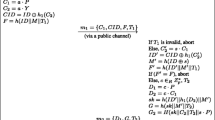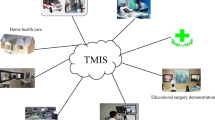Abstract
Telecare medicine information systems (TMISs) aim to deliver appropriate healthcare services in an efficient and secure manner to patients. A secure mechanism for authentication and key agreement is required to provide proper security in these systems. Recently, Bin Muhaya demonstrated some security weaknesses of Zhu’s authentication and key agreement scheme and proposed a security enhanced authentication and key agreement scheme for TMISs. However, we show that Bin Muhaya’s scheme is vulnerable to off-line password guessing attacks and does not provide perfect forward secrecy. Furthermore, in order to overcome the mentioned weaknesses, we propose a new two-factor anonymous authentication and key agreement scheme using the elliptic curve cryptosystem. Security and performance analyses demonstrate that the proposed scheme not only overcomes the weaknesses of Bin Muhaya’s scheme, but also is about 2.73 times faster than Bin Muhaya’s scheme.




Similar content being viewed by others
References
Lin, T. H., and Lee, T. F., Secure verifier-based three-party authentication schemes without server public keys for data exchange in telecare medicine information systems. J. Med. Syst. 38(5):1–9, 2014.
Arshad, H., and Nikooghadam, M., Three-Factor anonymous authentication and key agreement scheme for telecare medicine information systems. J. Med. Syst. 38(12):1–12, 2014.
Xie, Q., Zhang, J., Dong, N., Robust anonymous authentication scheme for telecare medical information systems. J. Med. Syst. 37(2):1–8, 2013.
Wu, F., and Xu, L., Security analysis and improvement of a privacy authentication scheme for telecare medical information systems. J. Med. Syst. 37(4):1–9, 2013.
Mishra, D., Srinivas, J., Mukhopadhyay, S., A secure and efficient chaotic map-based authenticated key agreement scheme for telecare medicine information systems. J. Med. Syst. 38(10):1–10, 2014.
Mishra, D., Mukhopadhyay, S., Kumari, S., Khan, M. K., Chaturvedi, A., Security enhancement of a biometric based authentication scheme for telecare medicine information systems with nonce. J. Med. Syst. 38(5): 1–11, 2014.
Kim, K. W., and Lee, J. D, On the security of two remote user authentication schemes for telecare medical information systems. J. Med. Syst. 38(5):1–11, 2014.
Mishra, D., Mukhopadhyay, S., Chaturvedi, A., Kumari, S., Khan, M. K., Cryptanalysis and improvement of Yan et al.’s biometric-based authentication scheme for telecare medicine information systems. J. Med. Syst. 38(6):1–12, 2014.
Mishra, D., Understanding security failures of two authentication and key agreement schemes for telecare medicine information systems. J. Med. Syst. 39(3):1–8, 2015.
Mishra, D., On the security flaws in id-based password authentication schemes for telecare medical information systems. J. Med. Syst. 39(1):1–16, 2015.
Mishra, D., A study on ID?based authentication schemes for telecare medical information system, arXiv:1311.0151, 2013.
He, D., Kumar, N., Chilamkurti, N., Lee, J. H., Lightweight ECC based RFID authentication integrated with an ID verifier transfer protocol. J. Med. Syst. 38(10):1–6, 2014.
Wu, Z. Y., Lee, Y. C., Lai, F., Lee, H. C., Chung, Y., A secure authentication scheme for telecare medicine information systems. J. Med. Syst. 36(3):1529–1535, 2012.
He, D., Chen, j., Zhang, R., A more secure authentication scheme for telecare medicine information systems. J. Med. Syst. 36(3):1989–1995, 2012.
Wei, J., Hu, X., Liu, W., An improved authentication scheme for telecare medicine information systems. J. Med. Syst. 36(6):3597–3604, 2012.
Zhu, Z., An efficient authentication scheme for telecare medicine information systems. J. Med. Syst. 36(6): 3833–3838, 2012.
Khan, M. K., and Kumari, S., An authentication scheme for secure access to healthcare services. J. Med. Syst. 37(4):1–12, 2013.
Lee, T. F., and Liu, C. M., A secure smart-card based authentication and key agreement scheme for telecare medicine information systems. J. Med. Syst., 2013. doi:10.1007/s10916-013-9933-8.
Das, A. K., and Bruhadeshwar, B., An improved and effective secure password-based authentication and key agreement scheme using smart cards for the telecare medicine information system. J. Med. Syst. 37(5):1–17, 2013.
Bin Muhaya, F. T., Cryptanalysis and security enhancement of Zhu’s authentication scheme for telecare medicine information system. Security and Communication Networks 8:149–158, 2015. doi:10.1002/sec.967.
Arshad, H., and Nikooghadam, M., An efficient and secure authentication and key agreement scheme for session protocol using ECC. Multimedia Tools and Applications, 2014. doi:10.1007/s11042-014-2282-x.
Kocher, P., Jaffe, J., Jun, B.: Differential power analysis. Proceedings of Advances in Cryptology, Vol. 1666, pp. 788–797, Santa Barbara (1999)
Messerges, T. S., Dabbish, E. A., Sloan, R. H., Examining smart-card security under the threat of power analysis attacks. IEEE Trans. Comput. 51(5):541–552, 2002.
Wang, D., and Wang, P., Understanding security failures of two-factor authentication schemes for real-time applications in hierarchical wireless sensor networks. Ad Hoc Netw. 20:1–15, 2014.
Ma, C.-G., Wang, D., Zhao, S.-D., Security flaws in two improved remote user authentication schemes using smart cards. Int. J. Commun. Syst. 27:2215–2227, 2014. doi:10.1002/dac.2468.
Klein, D. V. Foiling the cracker: a survey of, and improvements to, password security. In: Proceedings of the 2nd USENIX Security Workshop. Anaheim (1990)
Bonneau, J. The science of guessing: Analyzing an anonymized corpus of 70 million passwords. In: 33th IEEE Symposium on Security and Privacy (S&P 2012), IEEE Computer Society, pp. 538–552. San Francisco (2012)
Islam, S. H., Design and analysis of an improved smartcard-based remote user password authentication scheme. Int. J. Commun. Syst., 2014. doi:10.1002/dac.2793.
Hankerson, D., Menezes, A., Vanstone, S., Guide to elliptic curve cryptography. New York: Springer, 2004.
Von Ahn, L., Blum, M., Langford, J., Telling humans and computers apart automatically. Commun. ACM 47(2):56–60, 2004.
Jiang, Q., Ma, J., Li, G., Yang, l., An Efficient Ticket Based Authentication Protocol with unlinkability for wireless access networks. Wirel. Pers. Commun. 77(2):1489–1506, 2014.
Hsieh, W.-B., and Leu, J.-S., Anonymous authentication protocol based on elliptic curve DiffieHellman for wireless access networks. Wirel. Commun. Mob. Comput. 14:995–1006, 2014. doi:10.1002/wcm.2252.
Vanstone, S. A., Elliptic curve cryptosystem-the answer to strong, fast public-key cryptography for securing constrained environments. Inf. Secur. Tech. Rep. 12:78–87, 1997.
Stallings, W., Cryptography and Network Security: Principles and Practice. 4th edition. Upper Saddle River: Prentice Hall, 2005.
Author information
Authors and Affiliations
Corresponding authors
Additional information
This article is part of the Topical Collection on Systems-Level Quality Improvement
Rights and permissions
About this article
Cite this article
Arshad, H., Teymoori, V., Nikooghadam, M. et al. On the Security of a Two-Factor Authentication and Key Agreement Scheme for Telecare Medicine Information Systems. J Med Syst 39, 76 (2015). https://doi.org/10.1007/s10916-015-0259-6
Received:
Accepted:
Published:
DOI: https://doi.org/10.1007/s10916-015-0259-6




